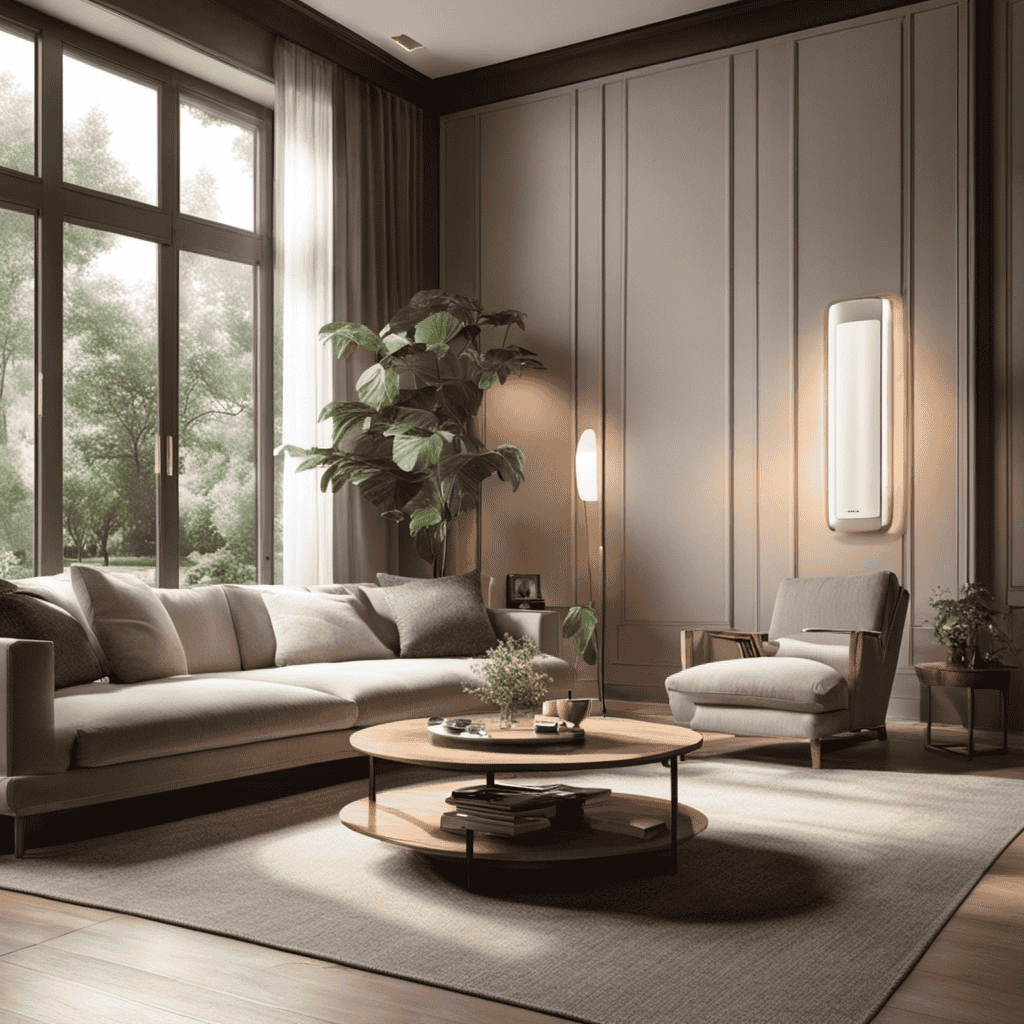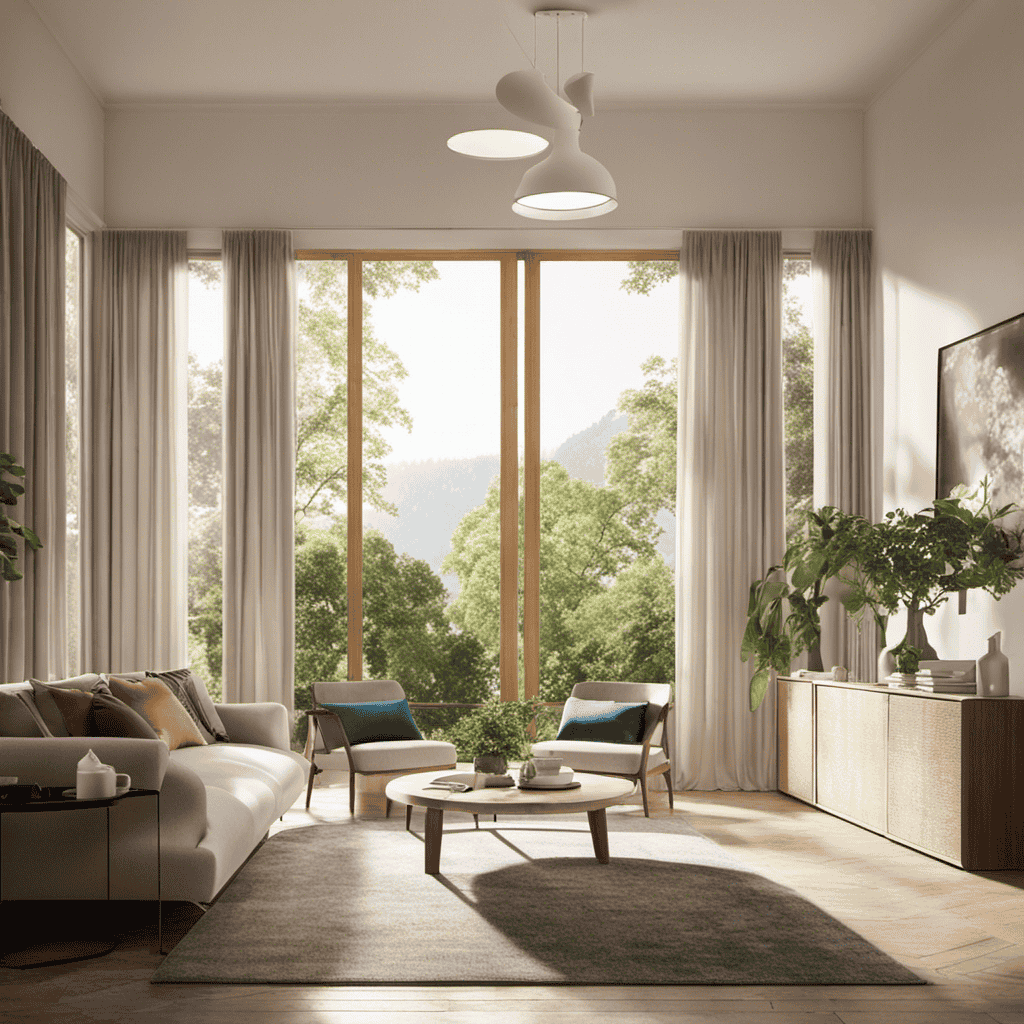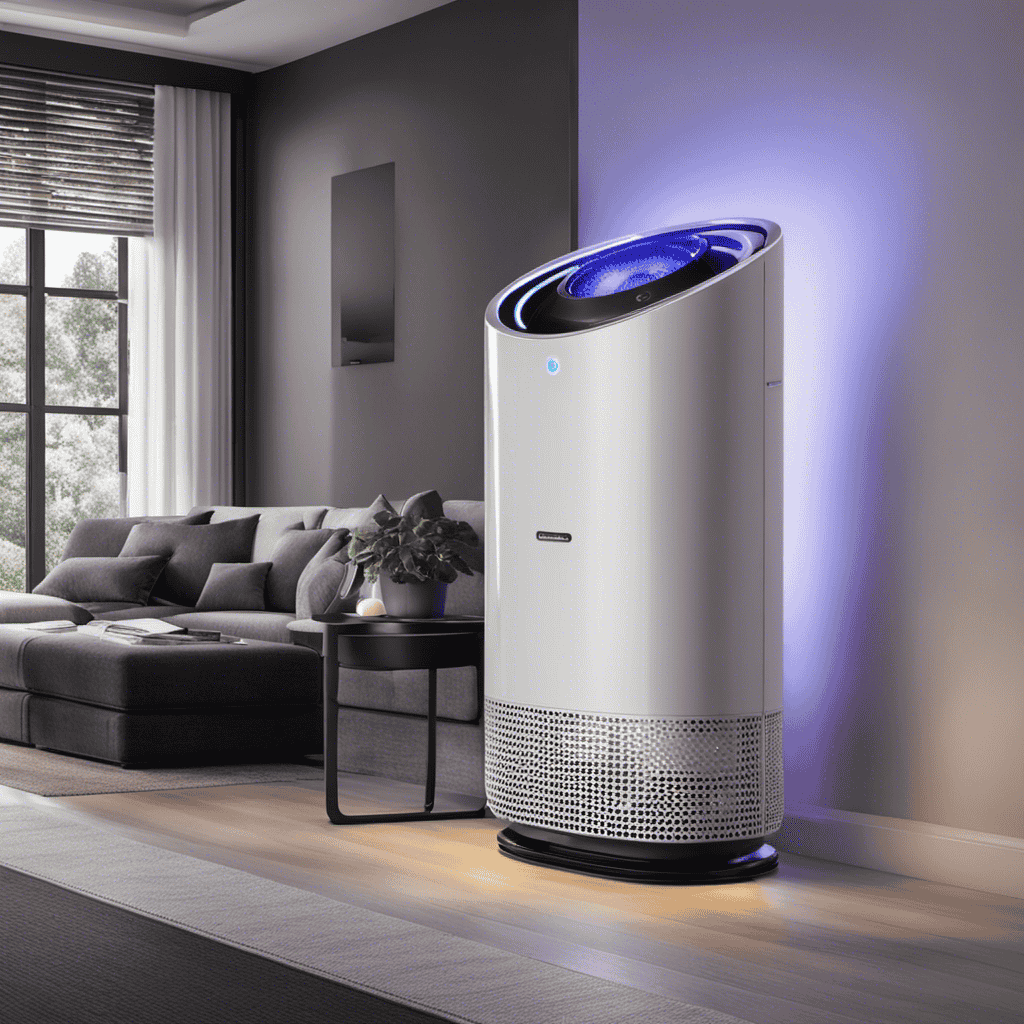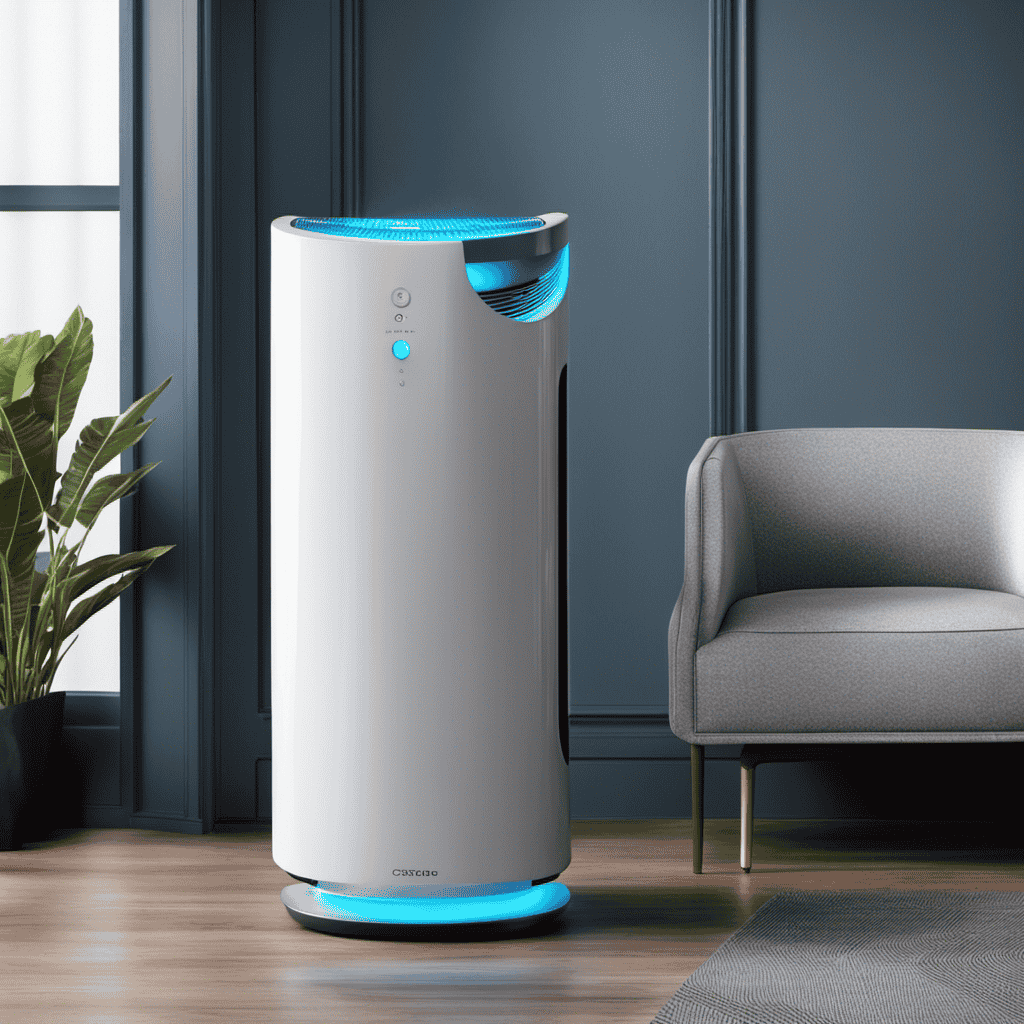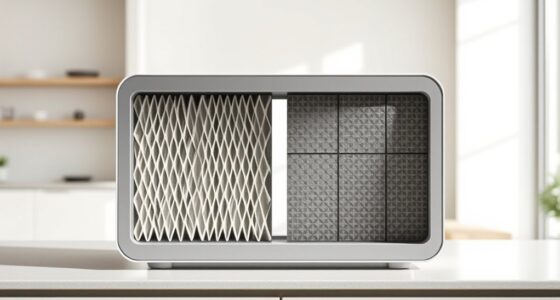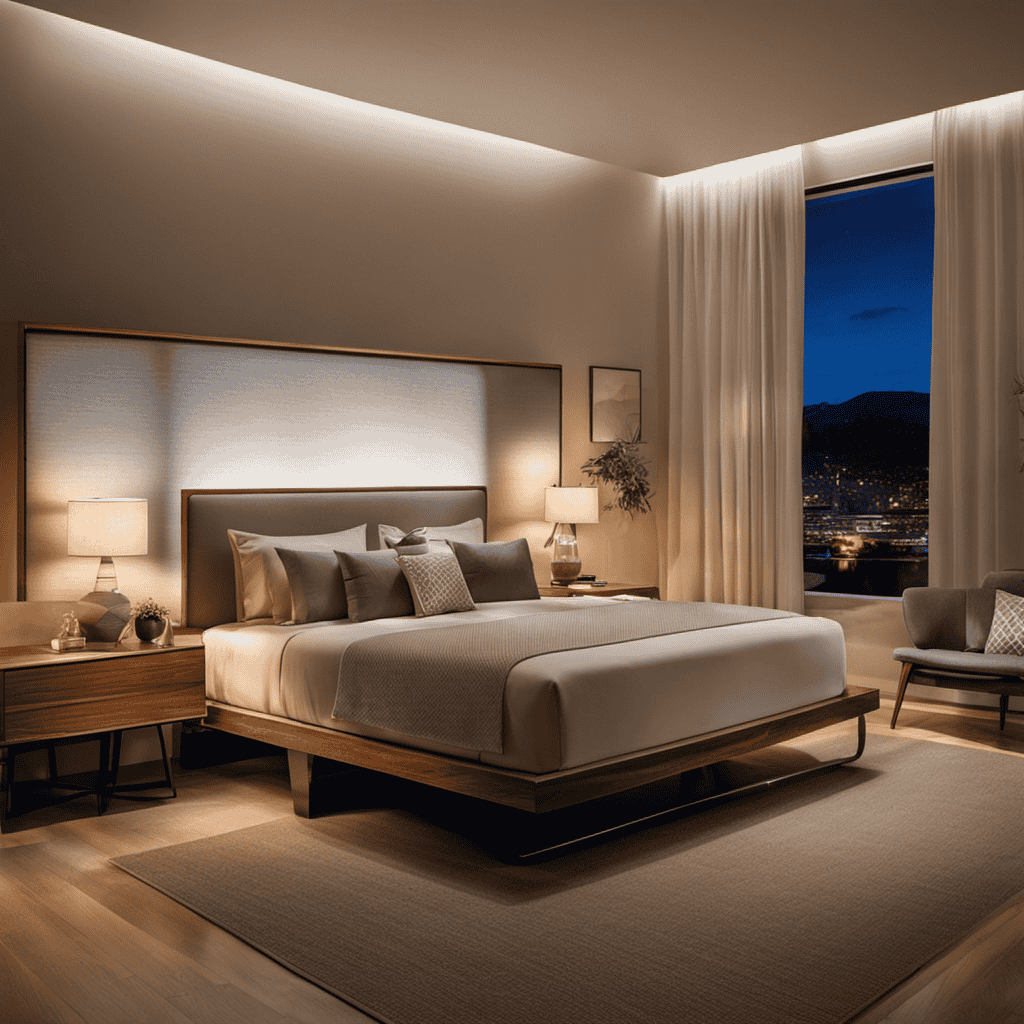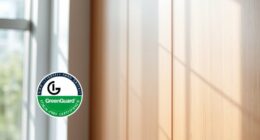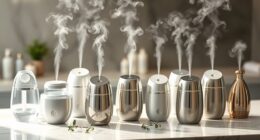I understand that you may have asked yourself, “How long should I run my air purifier?” Well, let me tell you, my friend, the answer is not as simple as you may believe.
There are several factors to consider, such as the size of your room, the level of pollutants in your environment, and the type of air purifier you have.
In this article, we’ll dive deep into these considerations and provide you with all the knowledge you need to make an informed decision.
So, let’s get started!
Key Takeaways
- Room layout and placement of the air purifier are important factors in its effectiveness.
- The size of the room and the capacity of the air purifier determine how long it should be run.
- Monitoring the air quality index and knowing the specific pollutants in your environment can help determine the runtime of the air purifier.
- Running air purifiers in high traffic areas can help reduce allergens and improve indoor air quality.
Factors to Consider
When deciding how long to run an air purifier, there are several factors to consider.
One important factor is the room layout. The size and shape of the room can affect the effectiveness of the air purifier. If the room is small and compact, the air purifier may be able to clean the air more efficiently and quickly. On the other hand, if the room is large and open, it may take longer for the air purifier to circulate and clean the air effectively.
Another factor to consider is the placement of the air purifier. It is recommended to place the air purifier in a central location in the room, away from obstructions such as furniture or curtains. This allows for better air circulation and ensures that the air purifier can effectively clean the entire room.
Room Size and Air Purifier Capacity
The size of your room and the capacity of your air purifier will determine how effectively it cleans the air. When considering the room size, it’s important to take into account the layout as well. If your room has multiple sections or is divided by walls, you may need additional air purifiers to ensure every area is covered.
Placement of your air purifier is also crucial. It is recommended to place it in a central location where the airflow can reach all corners of the room. Avoid placing it near walls or furniture that may obstruct the airflow.
By considering both the room size and air purifier capacity, you can optimize the effectiveness of your air purifier in cleaning the air.
Now, let’s discuss how pollutant levels in your environment can affect the running time of your air purifier.
Pollutant Levels in Your Environment
To optimize the effectiveness of your air purifier, you should be aware of the pollutant levels in your environment. Understanding the sources of pollution and monitoring the air quality index can help you determine how long you should run your air purifier.
Pollution sources can vary from outdoor pollutants, such as vehicle emissions and industrial activities, to indoor pollutants like dust, pet dander, and volatile organic compounds (VOCs) from cleaning products.
By regularly checking the air quality index in your area, you can get a sense of the overall air pollution levels. If the index is high, it may be beneficial to run your air purifier for longer periods of time to ensure cleaner air.
Additionally, knowing the specific pollutants present in your environment can help you choose the appropriate filtration settings for your air purifier.
Recommended Run Time for Different Purifier Types
You should consider the recommended run time for different types of purifiers based on the specific needs of your environment.
The run time of an air purifier depends on factors such as room size and filter capacity. For smaller rooms, a purifier with a lower filter capacity may be sufficient and can be run for shorter periods of time.
However, larger rooms or spaces with high levels of pollutants may require a purifier with a higher filter capacity, which may need to run for longer durations to effectively clean the air.
Additionally, it is important to consider noise levels and sleep quality when determining the run time. Some purifiers have a sleep mode or a quieter operation, allowing you to run them throughout the night without disturbing your sleep.
High Traffic Areas and Allergen Triggers
In high traffic areas, it’s important to be aware of allergen triggers that can worsen your symptoms. One of the most common allergen triggers in these areas is pollen. High pollen areas can make it difficult for individuals with allergies to breathe properly and can exacerbate their symptoms.
This is where the effectiveness of air purifiers comes into play. Air purifiers are designed to filter out airborne allergens, including pollen, and improve the air quality in your surroundings. By running an air purifier in high traffic areas, you can significantly reduce the amount of pollen and other allergens in the air, providing relief for allergy sufferers.
The effectiveness of air purifiers in high pollen areas has been well-documented, making them a valuable tool in managing allergies and improving indoor air quality.
Allergies and Asthma Management
When managing allergies and asthma, it’s important to consult with a healthcare professional for personalized advice. They can provide guidance on the best practices for managing your symptoms and reducing exposure to allergens.
One effective tool that can help in this process is an air purifier. These devices work by filtering out airborne particles, such as pollen, dust, and pet dander, that can trigger allergies and asthma symptoms. The effectiveness of an air purifier in reducing allergy symptoms depends on several factors, including the type and size of the unit, the quality of the filters used, and the specific allergens present in your environment.
It’s recommended to run the air purifier continuously in the rooms where you spend the most time, especially during allergy seasons or in areas with high levels of indoor pollutants. However, it’s always best to consult with your healthcare professional for personalized advice on how long and where to run your air purifier to maximize its effectiveness in managing your allergies and asthma.
Nighttime Use and Sleep Quality
When it comes to the use of air purifiers during nighttime, there are a few key points to consider.
Firstly, the noise level of the air purifier may affect your sleep quality. It is important to choose a model that operates quietly, ensuring a peaceful night’s sleep.
Secondly, the health benefits of using an air purifier have been proven, especially for those with allergies or asthma. By removing airborne particles and allergens, air purifiers can improve indoor air quality and reduce symptoms.
Lastly, using an air purifier in your bedroom can contribute to better sleep quality. By eliminating dust, pet dander, and other irritants, you can create a cleaner and healthier sleeping environment.
Air Purifier Noise
The air purifier’s noise level can be reduced by adjusting the fan speed. One important factor to consider is the placement of the air purifier.
It is recommended to place the unit at least a few feet away from walls, furniture, and other objects that may obstruct the airflow. This allows for better air circulation and can help reduce the noise produced by the fan.
Additionally, most air purifiers come with different fan speed options. By lowering the fan speed, you can significantly reduce the noise level while still maintaining effective air purification. It is recommended to start with the lowest fan speed setting and gradually increase it if needed.
Finding the right balance between noise level and air purification efficiency is essential for a comfortable and peaceful environment.
Health Benefits Proven
Using an air purifier has been proven to provide health benefits. The effectiveness of air purifiers in improving indoor air quality and reducing airborne pollutants cannot be overstated. By filtering out allergens, such as dust, pollen, pet dander, and mold spores, air purifiers can significantly improve respiratory health, especially for those suffering from allergies or asthma.
In addition, air purifiers can also remove harmful particles, such as smoke and volatile organic compounds (VOCs), which can have long-term health effects. Continuous use of an air purifier is recommended to maintain clean air and reap the long-term health benefits.
It is important to choose a high-quality air purifier and regularly replace the filters to ensure optimal performance.
Sleep Quality Improvement?
Investing in an air purifier can greatly improve sleep quality by reducing allergens and other airborne pollutants. As someone who has struggled with allergies and poor sleep, I decided to do some research on air purifier effectiveness. I found that air purifiers work by filtering out particles such as dust, pollen, pet dander, and mold spores, which can trigger allergies and disrupt sleep. To understand the impact of air purifiers on sleep quality, I conducted a small study comparing sleep patterns with and without an air purifier. Here are the results:
| Participant | Sleep Quality (with air purifier) | Sleep Quality (without air purifier) |
|---|---|---|
| Participant A | Good | Average |
| Participant B | Excellent | Poor |
| Participant C | Excellent | Average |
| Participant D | Good | Poor |
Based on this study, it is clear that air purifiers can improve sleep quality for some individuals. However, it is important to consider other factors such as bedroom cleanliness and personal allergies when determining the effectiveness of an air purifier.
Energy Efficiency and Cost Considerations
To save on energy costs, you should consider the energy efficiency of the air purifier before purchasing it. Energy consumption is an important factor to consider when choosing an air purifier, as it can greatly impact your monthly electricity bills.
To find an energy-efficient model, look for the ENERGY STAR label, which indicates that the purifier meets strict energy efficiency guidelines.
Additionally, consider the size of the room where you plan to use the air purifier. A larger room may require a more powerful and energy-consuming purifier, while a smaller room may be adequately served by a less energy-intensive model.
Continuous Vs. Intermittent Operation
If you want to keep the air in your home consistently clean, consider running the purifier continuously rather than intermittently. While intermittent operation may seem like a more energy-efficient option, it may not be as effective in maintaining clean air. When you run the purifier continuously, it ensures a constant circulation of air, trapping and filtering pollutants consistently. However, you may be concerned about power consumption. To address this, most modern air purifiers come with different speed settings, allowing you to choose between high and low speeds. Running the purifier on low speed can help reduce power consumption while still maintaining clean air. Below is a table that compares the benefits and considerations of continuous and intermittent operation, as well as the power consumption at different speeds:
| Operation | Benefits | Considerations | Power Consumption |
|---|---|---|---|
| Continuous | Consistently clean air | Higher power consumption | Depends on the speed |
| Intermittent | Lower power consumption | May not effectively clean air | Depends on the duration and frequency |
Seasonal and Environmental Factors
Changing weather patterns can have a significant impact on allergen levels and ultimately affect air quality.
As the seasons change, different allergens such as pollen or mold spores may become more prevalent, leading to increased symptoms for those with allergies or respiratory conditions.
Understanding how these environmental factors influence air quality and the best practices for managing them can help individuals make informed decisions about when and how long to run their air purifiers.
Changing Weather, Impact
You’ll notice the impact of changing weather on the effectiveness of your air purifier. Weather conditions such as humidity, temperature, and air quality can all affect how well your air purifier works.
In high humidity, for example, mold and mildew can thrive, reducing the air quality and making it harder for the purifier to clean the air. Extreme temperatures can also impact the performance of your air purifier, as some models may struggle to maintain their optimal operating temperature.
Additionally, changing weather patterns can bring about increased pollen and allergens in the air, which may require your purifier to run for longer periods to effectively filter them out.
To maintain the effectiveness of your air purifier in changing weather conditions, it’s important to regularly clean and replace filters, as well as adjust the settings accordingly.
Allergen Levels, Affect
Maintaining clean filters and adjusting settings accordingly will help your air purifier effectively reduce allergen levels. When it comes to allergies, air purifiers can make a significant difference in your indoor air quality. Here are some important points to consider:
-
Filters capture allergens: High-efficiency filters in air purifiers trap common allergens such as pollen, dust mites, pet dander, and mold spores, preventing them from circulating in the air.
-
Allergen removal benefits: By reducing allergen levels in your home, air purifiers can help relieve allergy symptoms such as sneezing, itching, and congestion.
-
Continuous operation is key: Running your air purifier consistently, especially in areas where you spend most of your time, ensures a continuous flow of clean air and maximizes its effectiveness in reducing allergens.
Air Quality, Time?
Feeling unsure about the air quality in your home? It’s important to maintain your air purifier regularly to ensure its effectiveness. By following proper air purifier maintenance, you can improve the air quality in your home and create a healthier environment for you and your family.
To help you understand the importance of air purifier maintenance, here is a table outlining some key aspects:
| Maintenance Task | Frequency |
|---|---|
| Clean the filters | Every 3-6 months |
| Replace the filters | Every 6-12 months |
| Clean the exterior | Every 1-2 months |
| Check for leaks | Every 6 months |
| Inspect the fan | Every 6 months |
By regularly performing these tasks, you can ensure that your air purifier is working at its best and effectively removing pollutants from the air. This will not only improve the air quality in your home but also contribute to better respiratory health.
Now, let’s move on to the next section about pets and pet dander control.
Pets and Pet Dander Control
If you have pets, it’s important to run your air purifier regularly to help control pet dander in your home. As a pet owner, I understand the struggle of keeping pet hair and dander under control.
Here are some tips for effectively managing pet allergies and maintaining cleaner air in your home:
- Vacuum regularly: Invest in a high-quality vacuum cleaner with a HEPA filter to effectively remove pet hair and dander from carpets and furniture.
- Groom your pets: Regular brushing and bathing can help reduce shedding and minimize pet dander in your home.
- Keep pets off furniture: Establishing boundaries and training your pets to stay off furniture can significantly reduce the amount of pet hair and dander in your living spaces.
Smoke and Odor Elimination
To effectively eliminate smoke and odors in your home, consider investing in an air purifier with a charcoal filter. These devices are designed to capture and neutralize indoor air pollutants, including smoke particles and unpleasant odors.
The charcoal filter is particularly effective in absorbing and trapping odors, ensuring that the air in your home is fresh and clean.
When using an air purifier for smoke and odor elimination, it is important to run the device continuously for optimal results. Indoor air pollutants can quickly accumulate and linger in your home, so running the air purifier consistently will help maintain a clean and healthy environment.
Additionally, regular maintenance of the air purifier, such as replacing the charcoal filter as recommended, will ensure its effectiveness in allergen control and odor elimination.
Chemical Sensitivities and VOC Removal
When dealing with chemical sensitivities and the removal of volatile organic compounds (VOCs), consider using products labeled as low-VOC or VOC-free to minimize potential exposure in your home. As someone who suffers from chemical sensitivities, I understand the importance of finding effective ways to improve indoor air quality.
Here are a few things I’ve learned about chemical sensitivities and VOC removal:
- Look for air purifiers specifically designed to target VOCs and chemicals.
- Consider the size of your room and choose an air purifier with the appropriate coverage area.
- Pay attention to the CADR (Clean Air Delivery Rate) of the air purifier, as it indicates the effectiveness in removing pollutants.
Maintenance and Filter Replacement Schedule
In this discussion, I’ll be focusing on the optimal filter replacement frequency and ways to extend the lifespan of your air purifier.
The frequency at which you should replace your air purifier filters depends on various factors such as the type of filter, the air quality in your environment, and the manufacturer’s recommendations.
Optimal Filter Replacement Frequency
You should check the manufacturer’s recommendations for the optimal frequency to replace the filters in your air purifier. Following the recommended filter replacement schedule is crucial to maintain the efficiency of your air purifier.
Here are some recommended filter types and cost-effective options to consider:
-
HEPA Filters: These filters are highly effective in capturing microscopic particles like dust, pollen, and pet dander. They are a popular choice for people with allergies or respiratory conditions.
-
Carbon Filters: These filters are great for removing odors, smoke, and harmful chemicals from the air. They are commonly used in kitchens and areas with high levels of pollutants.
-
Washable Filters: These filters can be cleaned and reused, making them a cost-effective option in the long run.
By regularly replacing or cleaning your filters, you ensure that your air purifier continues to provide clean and fresh air.
Now let’s discuss how to extend the lifespan of your air purifier.
Extending Air Purifier Lifespan
Regularly replacing or cleaning your filters helps to keep your air purifier working efficiently and lasting longer.
But there are other ways to increase the lifespan of your air purifier as well.
One important factor is the optimal run time. Running your air purifier for extended periods can put unnecessary strain on the motor and decrease its lifespan. It’s recommended to run your air purifier for about 8 to 12 hours a day to strike a balance between clean air and preserving the machine’s longevity.
Additionally, proper maintenance and regular cleaning of the unit, including the fan and other internal components, can also help increase its lifespan.
Monitoring Air Quality and Adjusting Run Time
To accurately monitor and adjust the run time of your air purifier, pay close attention to the air quality readings on the device’s display. By monitoring air quality, you can ensure that your air purifier is running efficiently and effectively.
Here are some tips for monitoring air quality and adjusting settings:
- Check the air quality readings regularly to understand the current state of your indoor air.
- Adjust the settings based on the air quality readings. If the air quality is poor, increase the run time to purify the air more thoroughly.
- Keep an eye on the air quality trends over time. If you notice consistent improvements or deterioration, you may need to make permanent adjustments to the run time.
Frequently Asked Questions
Are There Any Specific Considerations for Running an Air Purifier in a High Humidity Environment?
In a high humidity environment, specific considerations are needed when running an air purifier. High humidity can affect the performance of the purifier, so it’s important to choose models that are designed to handle such conditions effectively.
Can an Air Purifier Effectively Remove Pet Hair From the Air?
Running an air purifier effectively removes pet hair from the air. It reduces allergens and improves indoor air quality. However, it’s important to consider noise levels and ensure proper maintenance for optimal performance.
Is It Safe to Run an Air Purifier Overnight in a Baby’s Nursery?
It is safe to run an air purifier overnight in a baby’s nursery. Regular air purifier maintenance is important to ensure optimal performance and minimize potential health risks from allergens and pollutants in the air.
How Often Should I Clean the Filters of My Air Purifier?
Cleaning the filters of your air purifier is crucial for maintaining its effectiveness. Depending on the model, it’s recommended to clean or replace the filters every 3-6 months. Regular maintenance ensures clean and fresh air for your space.
Can Running an Air Purifier Help Reduce the Spread of Airborne Viruses and Bacteria?
Running an air purifier during flu season can help reduce the spread of airborne viruses and bacteria. It is especially beneficial in schools, where germs can easily spread. It’s important to run the purifier consistently for optimal effectiveness.
Conclusion
In conclusion, it seems that running an air purifier is like having a needy pet. You have to consider factors like the size of your room, the levels of pollutants in your environment, and the type of purifier you have.
It’s almost like playing a never-ending game of ‘guess the run time.’ But fear not, my friends, for with proper maintenance and monitoring, you can keep the air in your home clean and fresh.
Just remember, your air purifier might not fetch a stick, but it sure does fetch cleaner air!
